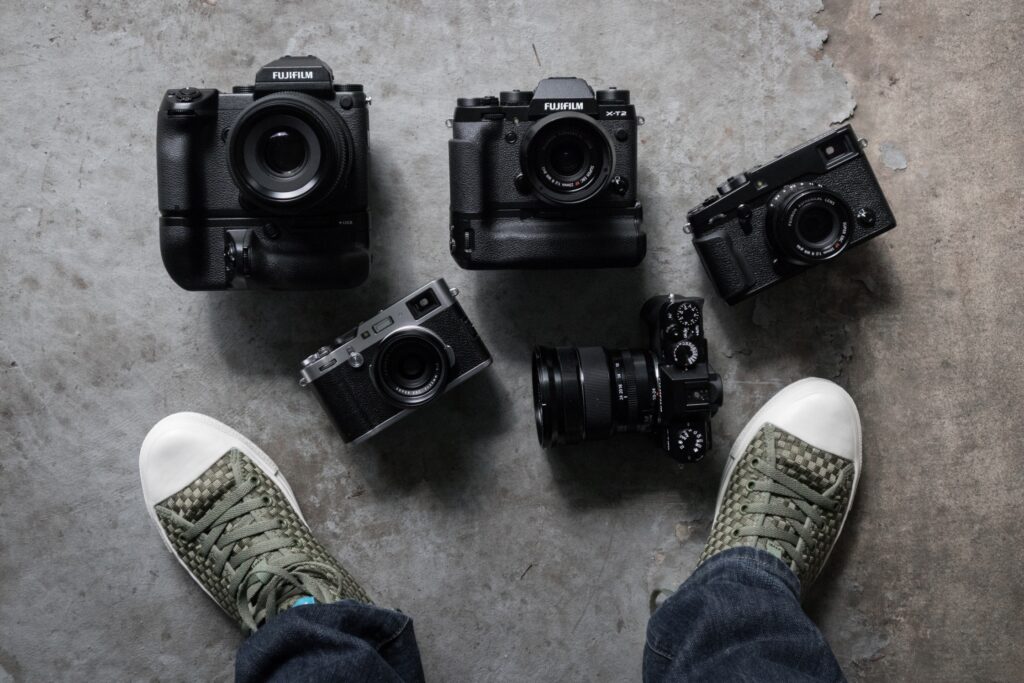Distance Converter
Before buying a camera, you need to learn about the product carefully so that you can choose the camera that is best for you. The article How To Choose A Camera For Photography will summarize the necessary information to help you find the best camera.
Basic camera classification
Camera classification is the division of cameras into several categories according to their operation, design, and intended usage. Several popular camera types include:
Point-and-shoot cameras are popular among amateur photographers because they are small and simple to use. They often have minimal human controls and automated functions.
DSLR (Digital Single-Lens Reflex) cameras let the photographer see precisely what the lens sees by using a mirror mechanism to transfer light from the lens to the viewfinder. They are popular among serious amateur and professional photographers and feature a broad variety of manual options.

Mirrorless cameras: Despite not using a mirror system, these cameras have a similar design to DSLRs. Instead, the image is recorded by the image sensor and shown on the LCD screen or electronic viewfinder. They are growing more and more well-liked because of their small size and cutting-edge characteristics.
Action cameras are commonly used in sports and adventure photography since they are built for capturing swift-moving action. They are compact, and strong, and frequently offer shockproof and waterproof properties.
Smartphone cameras: Many modern smartphones are equipped with high-end cameras that produce images and films that seem professional. They are handy and always by your side.
There are many more types and subtypes of cameras available; these are but a few instances of camera categorization.
What kind of camera should professional photographers choose?
Professional photographers frequently utilize mirrorless or DSLR (Digital Single-Lens Reflex) cameras. These cameras’ extensive manual controls and cutting-edge capabilities enable users to capture images of the highest caliber and appearance.
For many years, DSLR cameras have been the go-to option for professionals. They include quick focusing and high-speed burst settings, as well as a variety of interchangeable lenses so that photographers may select the right lens for the job.

Additionally, they contain an optical viewfinder that enables the photographer to see precisely what the lens is capturing. Professional photographers have been using mirrorless cameras more often in recent years.
They are smaller and lighter than DSLRs while yet having many of the same cutting-edge capabilities, making them easier to transport while shooting. Additionally, they contain an electronic viewfinder that may provide a range of shooting data and settings.
High-resolution picture sensors, quick focusing, and sophisticated capabilities like image stabilization and RAW image recording are all characteristics that both DSLR and mirrorless cameras provide.
In the end, the decision between a DSLR and a mirrorless camera will come down to individual tastes and the particular requirements of the photographer.
Depending on their requirements and the style of photography they specialize in, professional photographers may also employ additional specialist cameras, such as medium format cameras and technical cameras. This is the next information in How To Choose A Camera For Photography.
Requirements when choosing a camera for professional photographers
There are numerous important variables to take into account when selecting a camera for professional photography:
Image quality: A professional camera has to feature a high-resolution image sensor capable of taking precise pictures of excellent quality. The camera should be able to capture a variety of brightness levels in a single image thanks to its broad dynamic range.
Focusing: To swiftly capture clear photographs, an accurate and speedy autofocus mechanism is required. This is crucial for sports and action photography in particular.
Burst rate: A high burst rate enables the camera to quickly take several pictures. This is helpful for catching swiftly moving action or for taking several pictures of the same scene to guarantee that the best possible picture is obtained.

Professional photographers frequently need to move between various lenses for various sorts of photography. The optimal lens for the task may be selected by the photographer using a camera with interchangeable lenses. This is the next information in How To Choose A Camera For Photography.
Construction: Professional cameras must be strong and able to endure use-related wear and tear. To guard against moisture and dust, they have to be well built and weather-sealed.
Customization: Professional photographers frequently have to shoot in difficult lighting situations and must be able to swiftly change their camera settings. It is crucial to have a camera that enables comprehensive setting modification for things like ISO, shutter speed, and aperture.
Video capability: A camera that can record high-quality video is advantageous because many professional photographers also use video.
Battery life: Since a professional picture shoot might last for many hours, a camera with a long battery life is crucial.
Connectivity: Professional photographers need to be able to swiftly and conveniently transmit their photographs, so a camera with WiFi or Bluetooth built-in is beneficial.
Brand and Support: It’s critical to pick a camera from a well-known company that has a track record of manufacturing high-quality professional cameras. The accessibility of accessories and assistance is also crucial.
The ideal camera for a professional photographer will ultimately rely on their unique requirements and tastes. Before settling on a certain camera model, it’s crucial to do some research and test drives. This is the next information in How To Choose A Camera For Photography.
Conclusion
It is very important to consider each factor to choose the right camera for your needs. Hope the article How To Choose A Camera For Photography will provide useful information for you.
